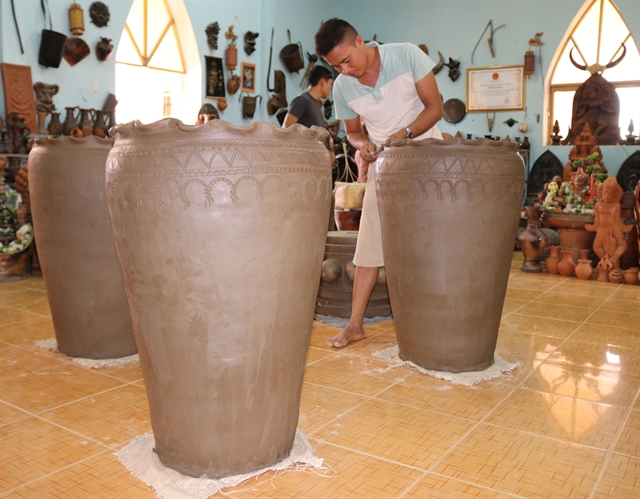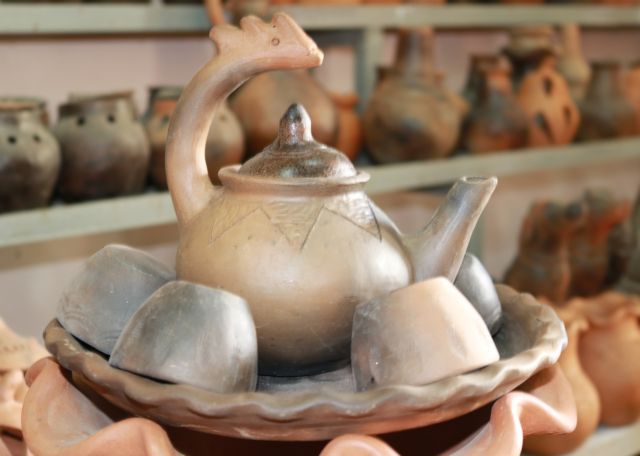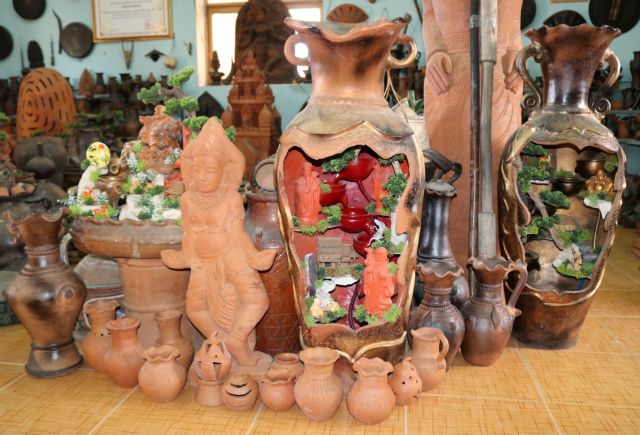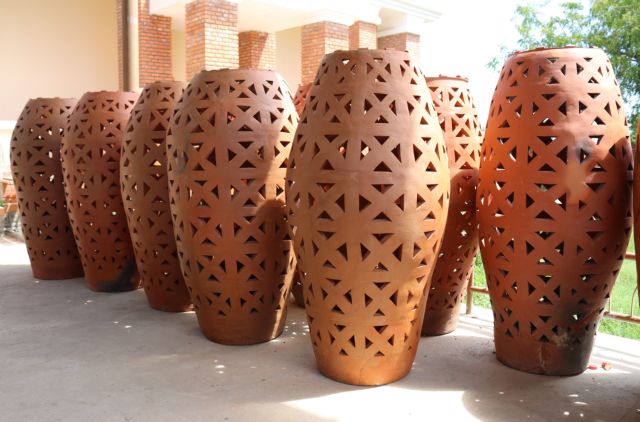 Features
Features

Established around 800 years ago by the Chăm people, the Bàu Trúc Pottery Village is one of the oldest craft villages of its kind in Southeast Asia.
by Nguyễn Thành - Ngọc Diệp

|
| A potter at work in Bàu Trúc Village, one of the oldest pottery villages in Southeast Asia. The village is located in Ninh Thuận Province’s Ninh Phước District. — VNA/VNS Photo Nguyễn Thành |
Established around 800 years ago by the ethnic Chăm people, the Bàu Trúc Pottery Village is one of the oldest craft villages of its kind in Southeast Asia.
The village, which has existed since the reign of King Po Klong Garai (1151-1205) of the Champa Kingdom, holds a ceremony every year to honour Po Klong Chan, its founder.
Today, it stands as a historic, cultural, and artistic landmark in the south-central province of Ninh Thuận.
In 2018, the village’s long-standing traditional craft was recognised as a national intangible cultural heritage by the Ministry of Culture, Sports and Tourism.
Traditional items
The Bàu Trúc Pottery Village has been famous for ceramic products made with clay from the Quao River.
Villagers take the soft clay and mix it with sand to create a base material and deploy skills and techniques handed down through successive generations.
The traditional Chăm pots are shaped by hand and are not made on a turning wheel. They are then dried in the sun for four to six hours before being fired outdoors.
The entire process is done by hand, from drying and soaking the materials in water to mixing sand and kneading the clay, to decorating the pots before firing them.
A product is placed on a chair or table and the potter places it on a stool or table, and walks around it, shaping it with anvils, moulds, and wet cloth.
Tree branches or shells are patterns often found on the traditional pots.
Because the potters here do not use kilns, the handmade jars are especially good for keeping water cool, locals say.
The natural colours of the pots, including reddish-brown, pinkish-red, and dark gray with brown streaks are characteristic of Chăm culture.
As soon as one passes through the village gate, it becomes clear what its main vocation is, with various pottery products lining the streets and placed in front of houses.
The village’s most popular items are reliefs featuring Chăm women, kings, or dancers, products used for worshipping deities, as well as everyday household utensils.

|
| A tea set made by the Bàu Trúc Pottery Cooperative in Ninh Thuận Province. — VNA/VNS Photo Nguyễn Thành |
Despite its long history, however, the village has struggled to come to face the modernisation challenge. The artisanal pottery mostly for domestic daily use and the advent of machine-made products with greater diversity of functions and designs posed a stiff challenge.
In response, the village’s artisans have begun creating new types of products with high aesthetic value, including decorative ones and souvenirs for tourists.
The village has one cooperative and 22 other pottery establishments with a total of 400 households engaged in the trade. Most of them are of Chăm ethnicity.
Together, the pottery establishments generate jobs for about 600 locals.
With gradual resumption of production after prolonged periods of closure caused by the COVID-19 pandemic, some of its usual bustle has returned to the Bàu Trúc Pottery Village Cooperative, with workers stepping up production, tourists visiting and shopping, and vehicles going up and down, transporting the village’s products.

|
| A tourist shops at the Bàu Trúc Pottery Village. — VNA/VNS Photo Nguyễn Thành |
Sprinkling water on a clay block while continuously kneading the clay, artisan Đàng Thị Nhánh said her family had been receiving more orders since the beginning of the year.
“All three family members are working hard to ensure that the orders are delivered on time to our customers,” she said.
Phú Hữu Minh Thuần, director of the cooperative, said it had 46 members. Among other things, the cooperative also ensured production associated with tourism while maintaining safety amidst the pandemic, he added.
Đàng Thị Tuyết Hằng, a member of the cooperative, said all members had received at least two doses of COVID-19 vaccine, so everyone felt secure about working.
“We are focusing on improving and diversifying our product designs and creating new ones to satisfy the tastes of customers,” she said.
Thuần said the cooperative was being proactive about finding solutions to boost production and also more outlets for its products.
The artisans had improved the design and quality of products that combine characteristics of western and Vietnamese culture in Chăm pottery, including decorative lamps, decorative water pots, feng shui products and flower pots, he said.

|
| The village is trying to develop attractive products that can meet tourists’ demand. — VNA/VNS Photo Nguyễn Thành |
The new products fetch higher prices than traditional pottery for household use.
The cooperative’s feng shui products, for instance, are priced between VNĐ1.2-3.5 million (US$52-152) per item.
Next, it plans to make more products for export. After increasing product diversity, the income of cooperative members has improved to around VNĐ5 million ($217) per month.
“The current demand for products used as interior and exterior decoration is very large. This is a very positive sign for the cooperative,” Thuần said.
The cooperative is also expanding its business channels to sell online on websites and social networks, according to Thuần.
It has just delivered 30 of 100 big flower pots more than 2m high each that had been ordered by a customer in Lâm Đồng Province’s Đà Lạt City.
It can now take in a large number of workers to produce and deliver products on time.

|
| Large decorative lampshades by the Bàu Trúc Pottery Cooperative in Ninh Thuận Province. — VNA/VNS Photo Nguyễn Thành |
On shaky ground
Despite the efforts being made to diversify products and designs to suit changing tastes and demands, Bàu Trúc Village is on shaky ground when it comes to competing against peers in other areas.
Many of its products have simple designs that cannot match the variety and modern style of ceramics made in the famous Bát Tràng pottery and Bình Dương pottery villages in the north and south of the country, respectively.
These days, many potters fear that they may become jobless because of their unstable output, low income, and lack of interest from traders.
Many households no longer engage in pottery, even though they still love the traditional work. They say they have to look for other jobs with better earnings.
To save the ancient craft, the provincial authorities have worked out several solutions, including financial support for registering an official village trademark, and more trade promotions at seminars and conferences.
They are also planning to compile a dossier on Chăm pottery in a bid to earn UNESCO’s cultural heritage recognition for this craft.
Ninh Thuận has three recognised traditional craft villages – Bàu Trúc for pottery, and Mỹ Nghiệp and Chung Mỹ for handloom weaving.
It also has dozens of craft villages that produce special products such as grape wine, dried jujubes, dried bamboo shoots, dried bananas, processed seafood, and fish sauce.
These villages have not just created thousands of jobs; they have also contributed to preserving the culture of different ethnic communities.
However, the development of craft villages in the province in recent decades has not matched their potential since the production efficiency of handicrafts is low. This is exacerbated by a shortage of capital and human resources and low competitiveness.
The province’s Department of Industry and Trade has taken several steps to address the situation, including investing in building new style rural areas and plans other interventions including technical demonstrations, creating a website for craft villages and helping organise exhibitions and trade fairs.
Provincial officials say craft villages will be helped to develop their own brands and participate in domestic and international fairs towards expanding markets. VNS




